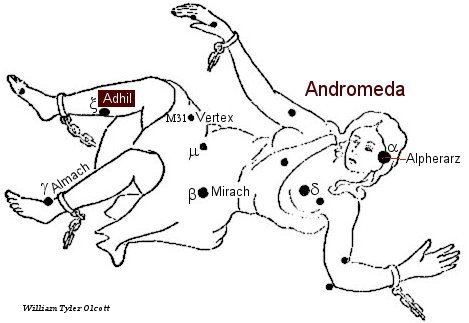| Fixed star: ADHIL | |
| Constellation: XI (ξ) Andromeda | |
| Longitude 1900: 06TAU28 | Longitude 2000: 07TAU52 |
| Declination 1900: +45.00′ | Declination 2000: +45.32′ |
| Right ascension: 01h 22m | Latitude: +33.49′ |
| Spectral class: G9 | Magnitude: 5.0 |
The history of the star: Adhil
from p.38 of Star Names, Richard Hinckley Allen, 1889.
[A scanned copy can be viewed on this webpage

The name Adhil, first appeared in 16th century starmaps, from Al Dhail, the Train of a Garment, the Arabic equivalent of Ptolemy’s (Greek) surma; but Baily thought the title (surma) better applied to the slightly fainter A, which is more nearly in that part of the lady’s dress.
With the surrounding stars, it partook of the nature of Venus.
Star Names, Their Lore and Meaning, Richard Hinckley Allen, 1889].
The astrological influences of the constellation Andromeda
Legend: Andromeda, the original “maiden in distress” is daughter of Cepheus, king of Ethiopeia, and his wife Cassiopeia. Cassiopeia was proud of her daughter’s beauty and boasted that Andromeda was more beautiful than the Sea Nymphs, the Nereids, who were daughters of Poseidon (Neptune). The Nereids complained to Poseidon who sent a sea monster (Cetus) to ravage the coast. With his kingdom in grave danger, Cepheus consulted the oracle of Ammon in Libya for advice. He learned the only way to save his kingdom was to sacrifice his daughter, Andromeda, to the sea monster. Andromeda is chained to a rock and left to the mercy of the monster. The hero, Perseus, riding through the air on winged sandals, arrives at the scene and they fall in love. Perseus had a quick consultation with Cepheus and Cassiopeia, it is agreed that if he rescues their daughter he could marry her. The sea monster (Cetus) arrives and Perseus kills it by turning it to stone with the Medusa’s Head (Algol). Perseus breaks the chains that bound Andromeda to the rock and frees her. The wedding follows.
According to Ptolemy the influence of this constellation is similar to that of Venus, though the legend would lead one to suppose some connection with Virgo. It is said to bestow purity of thought, virtue, honor and dignity upon its natives, but to cause battle with chimerical (wildly fanciful, highly improbable) fears and a tendency to become easily discouraged. It gives love between husband and wife and reconciles adulterers. If Mars afflicts the luminaries from Andromeda and especially if in an angle, it causes death by hanging, decapitation, crucifixion or impalement. By the Kabalists it is associated with the Hebrew letter Pé and the 17th Tarot Trump, The Stars. [Robson, p.26.]
The astrological influences of the constellation Andromeda given by Manilius:
The full English translation of the myth of Andromeda as told by Manilius in Astronomica, 1st century A.D. can be found on the Andromeda constellation page.
“The man whose birth coincides with the rising of Andromeda from the sea will prove merciless, a dispenser of punishment, a warder of dungeon dire; he will stand arrogantly by while the mothers of wretched prisoners lie prostrate on his threshold, and the fathers wait all night to catch the last kisses of their sons and receive into their inmost being the dying breath. From the same constellation comes the figure of the executioner, ready to take money for a speedy death and the rites of a funeral pyre, for him execution means profit, and oft will he bare his axe; in short, he is a man who could have looked unmoved on Andromeda herself fettered to the rock. Governor of the imprisoned he occasionally becomes a fellow convict, chained to criminals so as to save them for execution.” [Manilius,Astronomica, 1st century A.D., Book 5, p.351.]
References:
Fixed Stars and Constellations in Astrology, Vivian E. Robson, 1923].